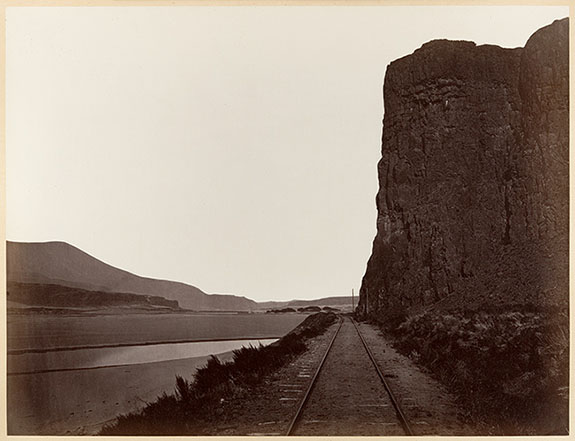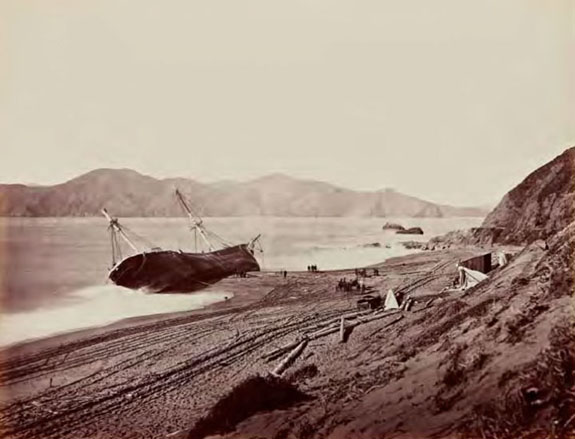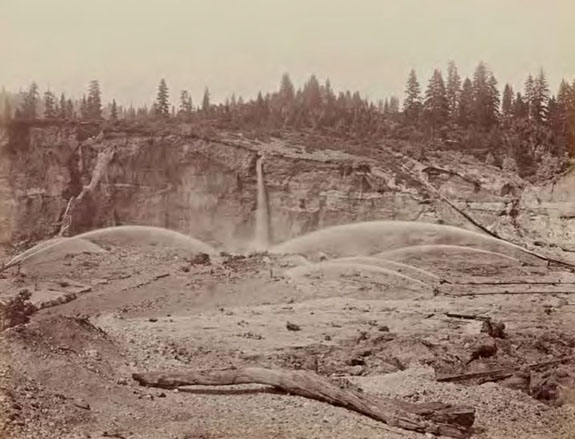 |
 |
home with the images of Paul Strand, Charles Sheeler, Walker Evans and other modernist photographers of a half-century later. To be sure, Watkins was not alone. Like his contemporaries William Henry Jackson and T.H. O’Sullivan, he was finding a new way to come to terms pictorially with the vast bold dramatic forms of the western American landscape.
.jpg) |
photographs. They were eventually exhibited in Paris, New York and Washington, inspiring President Lincoln and Congress to pass a law in 1864 to preserve Yosemite as a national park. The landscape painter Albert Bierstadt was so taken with Watkins’ photographs that he later came west to paint there.
Like so many of Watkins’ views, there is a sense of tranquility present in the way he harmonizes his compositions with skillful use of aerial perspective, contrasting dark tones in the foreground with delicately subtle rendering of highlights above, and with an overall simplicity of line and form. Composition in landscape photography ultimately comes down to knowing where to stand and place the camera. In moving through the landscape the photographer seeks the one place where all the three dimensional elements come together in a singular, easy to read, two- dimensional view. The rightness of where Watkins chose to stand was unerring.
 |
 |
For the albumen print, usually made back in the studio, a thin piece of paper was coated with an emulsion of albumen (egg white) and silver salts rendering the paper light-sensitive. After being dried in the dark, the paper was placed in contact with the glass negative in a frame and exposed in the sun. It was then fixed and toned in gold chloride to alter the color and contrast to the dark brown and blue-black tones of the finished print.
.jpg) |
In the early 1870’s he earned more awards and commissions but by the latter part of the decade his fortunes reversed. Watkins, never a good businessman, lost his studio to creditors, one of which reopened his studio with the photographer Isaiah Taber, who reprinted Watkins’s negatives and sold them under his own name.
Watkins regrouped, opening a new studio in San Francisco, starting a new series called Watkins’ New Series of Pacific Coast Views. He returned to Yosemite as well as other sites he had previously photographed. He worked on the Pacific coast from British Columbia to Southern California, and in other western states. Nevertheless for a number of years in the 1880’s he and his family were destitute, eventually saved by his friend and patron Collis P. Huntington, with the gift of a ranch in Yolo County.
In the 1906 San Francisco earthquake Watkins’s studio was destroyed along with his glass plate negatives and prints. He was destroyed as well, never recovering from the loss. In 1909 one of the greatest American artists of the nineteenth century was declared insane and committed to the Napa State Hospital where he died in 1916.
Watkins was liberated by the pearlescent images glowing on his ground glass, this coupled with a lack of formal art training, freed him to pursue his innate vision. His
contact prints from a over a century ago seem to ask, “What have you learned”? Carlton Watkin’s work is clearly beacon but also a gauntlet.
Photographers today are freed from the technical environment that Watkins thrived in, so we gorge on the empty calories of countless “amazing” or “awesome” pictures.
In the last 24 hours a billion photographs have been added to our visual diet, yet how many nourish us? It seems with more we get less.